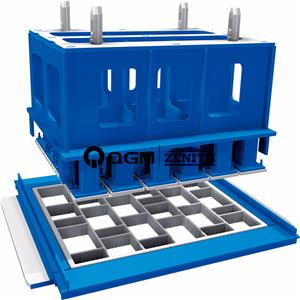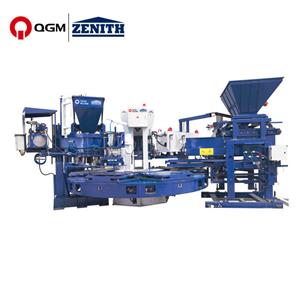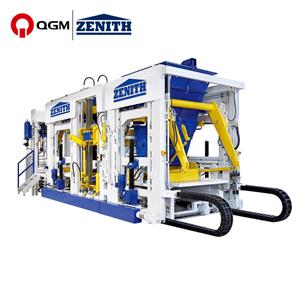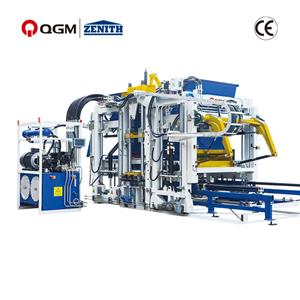Brick machine manufacturing industry found the status quo and development prospects
1. Overview of brick machine manufacturing industry
Brick making machine generally uses stone powder, fly ash, slag, slag, gravel, sand, water and other cement as raw materials through hydraulic power, seismic power, aerodynamic power to produce bricks.
With the development of mechanical technology, the current new brick making machine can efficiently use fly ash, slag, stone powder, desulphurized ash, slag, coal gangue, phosphogypso, tail ore and other new wall materials, such as autoclaved fly ash brick, autoclaved lime sand brick, aerated concrete products. On the one hand, the new wall material can effectively use fly ash, slag, and even industrial waste slag, and carry out waste recycling; On the other hand, its environmental protection and energy saving, new wall materials have also been strongly supported and affirmed by the state.
(1) The development history of China's brick machine manufacturing industry
In the late 1920s, small-scale production of brick and tile machinery accessories and equipment appeared on the basis of some state-owned brick and tile factories' own mechanical maintenance. In the late 1970s, it was separated from the brick factory to form a specialized brick machinery factory. In the late 1980s, the number of brick and tile machinery production enterprises increased from more than a dozen to dozens. Since 1990, China has begun the renovation of wall materials and building energy conservation work, and started a new round of technological innovation. The processing and preparation of a variety of complex raw materials, vacuum extruder, etc., provide advanced equipment for the production of energy-saving, land-saving, waste-benefiting and environment-friendly new wall material products, and promote the development of tile production to mechanization and automation.
(2) Development pattern of brick machine manufacturing industry
In the brick machine manufacturing industry, the United States, Germany belong to the first echelon, Denmark, Greece, Italy, Japan, South Korea and other countries are the second echelon, while China, Turkey and other countries are the third echelon, the strength has been close to the level of the second echelon, but still in the initial stage of industrial development. The number of domestic machinery manufacturing enterprises for the production of building materials is currently in a stable stage.
2. Industry market status
Domestic market: due to many factors such as cost performance, personalized demand, after-sales service, domestic equipment has basically replaced imported equipment to become the first choice for wall material manufacturers. China's brick machine manufacturing industry has developed rapidly, especially since 2006, with the acceleration of China's urbanization process, the rapid development of the construction industry, municipal construction and other industries, the demand for new building materials continues to increase, making the scale of brick machine manufacturing enterprises continue to expand.
Overseas market: China's wall forming machinery products are gradually expanding overseas market share by virtue of their cost-effective advantages, and the quality of their products has been close to international standards. From the price point of view, due to the huge cost advantage of our products compared with European and American products, similar products are only equivalent to 20%-50% of the same products in foreign countries, and the product quality is gradually improved, and the product cost-effective advantage is larger, especially for the demand of developing countries and regions, with a certain international market competitiveness.
Affected by the slowdown of China's economic development and the global economic malaise, in recent years, the cumulative growth rate of industrial sales output value of China's construction materials production special machinery manufacturing industry has declined, but the year-on-year growth rate is still at a high value, and the gross profit margin of the entire industry is maintained at more than 10%. And with the introduction of the national new industrial policy, energy-saving and environmental protection, multi-functional brick products have gradually replaced the traditional brick products, and the brick production line has gradually been updated. The market demand for high-tech and new brick making equipment is increasing.
3, industry development prospects
(1) The growing demand for energy conservation and environmental protection
China's solid waste is mainly from industrial waste, according to the Ministry of Ecology and Environment statistics show that in 2019, the national industrial solid waste production of 3.543 billion tons, an increase of 1.68% over the previous year. The next few years will be a critical period for China's urbanization to maintain rapid development and build a well-off society in an all-round way. It is extremely important and urgent to make reasonable use of solid waste, reduce the damage caused by solid waste to the environment, organize the implementation of construction material reform projects, and find new building materials that are environmentally friendly, energy-saving and beneficial to waste.
(2) Brick products are developing in the direction of diversification, energy saving and environmental protection, and gradually entering the international market
At present, the varieties of brick products in China have developed from a single solid clay brick to many varieties and specifications of sintered porous brick, hollow brick, insulation brick, insulation hollow block, composite insulation brick, composite insulation hollow block, wall and floor brick, road brick, coal gangue brick, fly ash brick, wall decorative board and sintering tile and other sintering products; And autoclaved lime sand brick, autoclaved fly ash brick and other non-sintered products. The types of products from solid brick to hollowing, high hole rate, energy saving, soil saving, waste, environmental protection products direction, the industry gradually optimized, the quality gradually increased, the product appeared a variety of varieties and specifications to meet the different needs of the construction market. At the same time, low-grade products began to show the trend of elimination.
At present, the domestic brick machinery manufacturing industry enterprises have gradually established a perfect internal management system, and their research and development capabilities have been continuously enhanced. Especially in terms of market development, on the one hand to provide reliable quality products, on the other hand closely around the national industrial policy, multi-variety and multi-channel development, the launch of equipment products that meet the market demand, to meet the wall material innovation and building energy conservation requirements.
With the continuous improvement of product quality and technical level of the brick manufacturing industry, domestic enterprises have gradually narrowed the gap with the international advanced level, and the advantage of the high cost performance of domestic products has gradually entered the Middle East, Africa, Eastern Europe, India, Southeast Asia and other markets, the future international market will become the key expansion target of Chinese manufacturers.
5. Industry risk analysis
(1) Risk of disorderly market competition
Through the introduction, digestion and absorption and re-innovation, China has grown up a large number of advanced brick and tile equipment enterprises, but there is also no shortage of low-quality low-end equipment enterprises on the market, copying is serious, driven by interests, the use of inferior materials, manufacturing some low-quality equipment. Taking tunnel kiln manufacturing as an example, the development of tunnel kiln in China is very fast, but it also brings many uncertainties and engineering quality accidents, and the kiln types of various sizes and sections are varied, and some kiln body structure design has hidden dangers. Although the state has explicitly ordered the elimination of wheel kilns below 24 doors as well as shaft kilns, no-top wheel kilns, horseshoe kilns, etc., earth kilns still cannot be eliminated. Due to insufficient policy implementation, it is difficult to eliminate low-quality and low-end products and process equipment. Therefore, the industry enterprises face the risk of disorderly competition in the market.
(2) Risk of talent shortage
At present, the number of graduates from relevant majors in China's colleges and universities to work in brick manufacturing enterprises for a long time is very small, the lack of vocational skills training of enterprise employees, the lack of modern management knowledge of some enterprise leaders, the lack of professional and technical personnel of enterprises, and the weak ability of technological innovation, resulting in the development and market application of new products are restricted. On the other hand, the industry lacks high-end technical talents, and enterprises are also facing the risk of brain drain caused by peer poaching.
(3) Risk of demand fluctuation in downstream industries
The downstream industry of brick machine manufacturing is a brick and new wall material production enterprise, and the terminal application fields of the industrial chain include housing construction, railway and highway roadside, bridge, dock, drainage engineering construction and pedestrian road, square, garden, water and soil conservation and other municipal engineering construction, and mainly housing construction. At present, the domestic real estate inventory pressure is large, and the growth of real estate development investment is slowing down, which directly affects the development of upstream industries. If the demand of the downstream industry continues to decline, it will have a greater impact on the expansion of the scale of enterprises in the industry.





